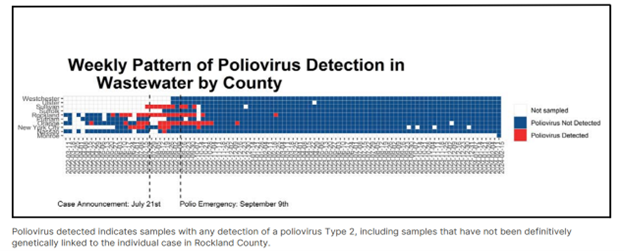Vaccine Update: ACIP Recommends Primary Polio Series for All Adults
Vaccine Update - March 2024
Column Author: Maria Martinez, RN, BSN, MSN, MBA, CPN | Immunization Coordinator
Column Editor: Angela Myers, MD, MPH | Pediatric Infectious Diseases; Division Director, Infectious Diseases; Medical Director, Center for Wellbeing; Professor of Pediatrics, University of Missouri-Kansas City School of Medicine; Clinical Assistant Professor of Pediatrics, University of Kansas School of Medicine
Polio had been eliminated in the United States in 1979, yet the recent paralytic polio case that occurred in New York in 2022, is a reminder that if polio is not eradicated globally, and anyone that is unvaccinated will continue to be at risk.
The Advisory Committee on Immunization Practices (ACIP) recently updated their recommendation for adult Polio Vaccination. The new recommendation is that all adults unvaccinated against polio or with an incomplete or unknown polio vaccination status, complete a primary polio vaccination series with inactivated polio vaccine (IPV). Additionally, adults who are at increased risk for poliovirus exposure can receive a single lifetime booster dose of IPV. (1) Prior recommendation was that only adults at increased risk for poliovirus receive additional polio vaccination.
Polio is a highly infectious virus. The main mode of transmission is through the fecal-oral route. While less common, it can also be transmitted through contaminated food or water. Once it enters the body, it replicates in the intestines. (2) Most people that become infected will not develop any symptoms. Of those infected, 25% will develop flu like symptoms, one in 25 will develop viral meningitis and one in 200 will develop paralysis. (3) Of those paralyzed, 5-10% suffer immobilization of the respiratory muscles which can lead to death. (2) Symptom onset is three to six days post exposure. Paralysis onset typically starts seven to 21 days post exposure. (3)
While investigating the paralytic polio case in New York, wastewater data demonstrated that poliovirus had been circulating without notice for months. The polio case was announced on July 21, 2022 and wastewater samples showed poliovirus detections starting in April of 2022 within Orange County, New York. Ongoing wastewater surveillance last detected poliovirus in Rockland County, New York in February 2023. (4) Wastewater samples genetically linked the poliovirus detections in New York to poliovirus found in London, Jerusalem, and Canada. (5) The unvaccinated adult who contracted polio in New York had not traveled internationally but had attended a large gathering eight days prior to symptom onset, indicating they acquired the virus from someone in the community. (6) Community transmission was likely fueled by low vaccination rates in Rockland County, New York. Some county zip codes reported IPV vaccination rates as low as 37% for children < 2 years of age who received 3 doses of vaccine. Nationally, children 2 years of age that have received vaccination with 3 doses of IPV was 93.4%. (1)
Figure A- Poliovirus Wastewater Surveillance Report (ny.gov)

Assessment:
Globally, we continue to see countries in which polio is endemic (Afghanistan and Pakistan) or where clusters of cases occur. (Figure B) Many of these countries use oral polio virus vaccine. The oral polio virus vaccine uses a live weakened virus. This vaccine is most used in areas with limited resources due to its lower cost and ease of handling and administration. While this vaccine is highly effective, it comes with the drawback that it can mutate and evolve and can become infectious. While vaccine-derived outbreaks are rare, they most frequently occur in communities with low polio vaccination rates in which the virus has been able to replicate for an extended period of time leading to the mutation of the infectious strain. (NIH Novel Vaccines) There is promise however, that a newer oral polio virus vaccine- the type 2 novel oral polio vaccine (nOPV2) which is genetically stable, will be less likely to evolve. Minimizing virus mutations would help reduce vaccine derived polio outbreaks. Since it’s production in March 2021, it is estimated that 1 billion nOPV2 doses have been administered across 35 countries globally. (7,8)
Figure B. Polio Now – GPEI (polioeradication.org)

Recommendation:
Polio vaccination is critical in the ongoing efforts for world-wide polio eradication. While many adults in the United States have been vaccinated against polio, it is critical that we discuss and review vaccination status with patients. Adults that are unvaccinated should receive three doses of IPV at the following intervals:
- Dose 1: any time
- Dose 2: 1 or 2 months after the first dose
- Dose 3: 6-12 months after the second dose
Additional guidance for incompletely vaccinated adults or for adults needing an accelerated vaccination schedule can be found on the CDC website: Polio Vaccination Recommendations for adults. As always, adults who are traveling to an area where polio is endemic or where there are ongoing cases should receive a booster before travel even if they have known receipt of the initial series.
References:
- Accessed 2/22/2024 Use of Inactivated Polio Vaccine Among U.S. Adults: Updated Recommendations of the Advisory Committee on Immunization Practices — United States, 2023 | MMWR (cdc.gov)
- Accessed 2/26/2024 Poliomyelitis (who.int)
- Accessed 2/22/2024 Polio - NYC Health
- Accessed 2/26/2024 Poliovirus Wastewater Surveillance Report (ny.gov)
- Accessed 2/28/24 Poliovirus outbreak in New York State, August 2022: qualitative assessment of immediate public health responses and priorities for improving vaccine coverage - PMC (nih.gov)
- Accessed 2/22/24 How polio silently spread in New York and left a person paralyzed (cnbc.com)
- Accessed 2/26/24 Novel vaccines may help quell polio outbreaks | National Institutes of Health (NIH)
- Accessed 2/26/2024 4 Million Children Receiving New Polio Vaccine — Precision Vaccinations News
See all the articles in this month's Link Newsletter
Stay up-to-date on the latest developments and innovations in pediatric care – read the March issue of The Link.
